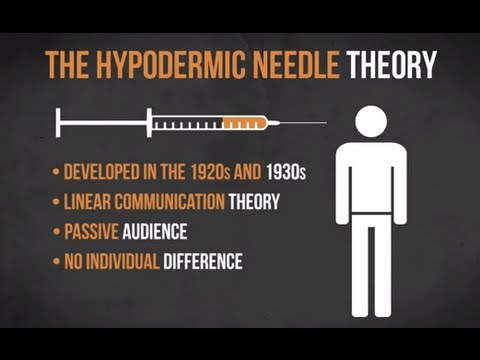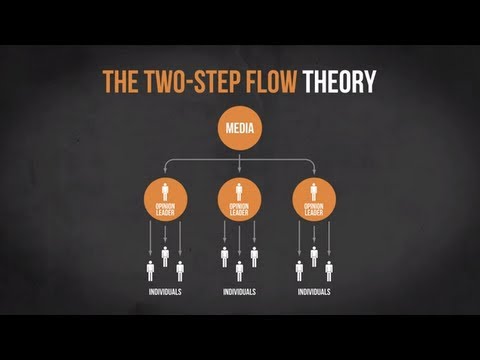8.6: Grounding Theories of Mass Communication
- Last updated
- Save as PDF
- Page ID
- 42895
Almost forty years ago Osmo Wiio argued that mass communication does not accurately portray reality. Interesting that all this time later we now have a large number of “reality tv” shows that continue to blur the lines of reality and fiction. Are you always able to tell the difference between fiction and reality in mass communication? Most people tend to rationalize that others are more affected by mass communication than they are (Paul, Salwen, & Dupagne). However, we are all susceptible to the influence of mass communication.
As we discussed in Chapter 5, theories are our best representations of the world around us. “Mass communication theories are explanations and predictions of social phenomena that attempt to relate mass communication to various aspects of our personal and cultural lives or social systems” (Baran 374). We need to be discerning as we examine mass communication (Baran). “The beginning of the television age in the 1950s brought in visual communication as well as stimulated the rise of an interdisciplinary theory of the media. Contributions were made from economics, history, literature, art, political science, psychology, sociology and anthropology, and led to the emergence of academic departments of communication and cultural studies” (Briggs & Burke 2). Mass communication theories explore explanations for how we interact with mass communication, its role in our lives, and the effects it has on us.
Let’s look at five fundamental theories of mass communication: 1) the magic bullet theory, 2) two-step flow theory, 3) multi-step flow theory, 4) uses and gratification theory, and 5) cultivation theory.
- Magic Bullet Theory. The magic bullet theory (also called the hypodermic needle theory) suggests that mass communication is like a gun firing bullets of information at a passive audience. “Communication was seen as a magic bullet that transferred ideas or feelings or knowledge or motivations almost automatically from one mind to another” (Schramm 8). This theory has been largely discredited by academics because of its suggestion that all members of an audience interpret messages in the same way, and are largely passive receptors of messages. This theory does not take into account intervening cultural and demographic variables such as age, ethnicity, gender, personality, or education that cause us to react differently to the media messages we encounter. However, many people hold the assumption that media, like television news outlets, simply release information that doesn’t encourage audience engagement and critical thinking. Rather than give a story with an unbiased message, that would allow a consumer create an opinion for themselves, media news outlets present stories to audiences that are attractive to them. Those who believe reality television shows actually portray reality hold some assumptions of the magic bullet theory.
Mass Communication Study Now
One of the things that has occurred in mass communication during the Iraq war is the absence of images and coverage of American soldiers killed in action. The American government has asked that the media refrain from using these images in their publications. As we have talked about how individuals now have the ability to engage in mass communication, Paul Mcleary (2008) wrote an article for the Columbia Journalism Review entitled “Blogging the Long War.” In it, he examines the rise of independent reporters using blogs to report events occurring in Iraq and Afghanistan that people may not be able to see in mainstream media. As a result of access to outlets like blogs, individuals, such as soldiers can do their own reporting, and others are able to access alternative sources of information. How do you think these new outlets impact our world view?
Take a few minutes to view this Hypodermic Needle Theory Video that further summarizes and explains the theory.

A YouTube element has been excluded from this version of the text. You can view it online here: pb.libretexts.org/introductiontocommunication/?p=162
- Two-Step Flow Theory. After World War II, researchers began noticing that not all audiences react in the same ways to mass communication. Media had less power and relatively less affect than previously assumed (Klapper). The two-step flow theory suggests that mass communication messages do not move directly from a sender to the receiver (Katz & Lazarsfeld). Instead, a small group of people, gatekeepers, screen media messages, reshape these messages, and control their transmission to the masses. Opinion leaders initially consume “media content on topics of particular interest to them” and make sense of it based upon their own values and beliefs (Baran). In the second step, the opinion leaders filter and interpret the messages before they pass them along to individuals with shared ideologies who have less contact with the media, opinion followers. An example of this theory occurs during political campaigns. Research has shown that during an election, media influence your voting preferences (Lazarsfeld, Berelson, & Gaudet) through the information they choose to show about a candidate. This research can still be applied to current political campaigns. Pope Francis has over 4 million followers on twitter and is one of the most re-tweeted social leaders. He uses social media to engage and influence his followers about what’s going on in the world. Also, President Obama’s use of social media is highly credit as a key factor in the 2008 election. Conservatives often argue that they are marginalized by the “liberal media,” while liberals argue that they are marginalized because wealthy conservatives own and control the media. Either way, research reveals that media dependency becomes increasingly important for the public especially during political campaigns (Jeffries). You can watch a short video on the Two-Step Flow Theory.

A YouTube element has been excluded from this version of the text. You can view it online here: pb.libretexts.org/introductiontocommunication/?p=162
- Multi-step Flow Theory. This theory suggests that there is a reciprocal nature of sharing information and influencing beliefs, attitudes, and behaviors (Troldahl; Troldahl & Van Dam). The idea is that opinion leaders might create media messages, but opinion followers might be able to sway opinion leaders. Thus, the relationship to media becomes much more complex. Some believe that the role of the opinion leader in our changing culture is diminishing (Baran; Kang) particularly with the ability for average people to reach potentially millions of people through social media. You’ve likely heard the term “going viral” which is something that could not have happened even ten-fifteen years ago. This mediated diffusion de-bunks the notion of an all powerful media but still recognizes that media have some effect on the audience.
- Uses and Gratification Theory. The uses and gratification theory suggests that audience members actively pursue particular media to satisfy their own needs. “Researchers focus their attention, then, on how audiences use the media rather than how the media affect audiences” (Berger 127). The reciprocal nature of the mass communication process no longer sees the media user as an inactive, unknowing participant but as an active, sense-making participant that chooses content and makes informed media choices. We tend to avoid media that do not agree with our values, attitudes, beliefs, or pocketbooks. Schramm argued that we make media choices by determining how gratified we will be from consuming a particular media. Is it easier for you to read a newspaper or would you rather watch television or listen to the radio? Even with all the information on the internet, there are still some people who consider it too time consuming and complex. Yet, many of our students do not have television sets, but instead watch all television, movies, and videos online. Streaming shows online helps us avoid commercials and media content in which we choose not to participate. Netflix, for example, requires a monthly fee in order for you to be commercial free during your shows, but usually you have to wait a season to watch shows. Whereas, Hulu charges under $5 for their services and share 2-5 commercials per episode, but you can watch the shows during the original season they are aired. These new ways of watching television have allowed the consumer to make active choices about what media the use and consume.
Mass Communication Study and You
Do you do most of your research using search engines like Google or Yahoo? There had been an assumption that today’s younger generation is the most web-literate. However, a study carried out by the CIBER research team at the University College London states today’s youth “rely heavily on search engines, view rather than read and do not possess the critical and analytical skills to assess the information that they find on the web.” The same study showed that people of all ages who use the internet have a low tolerance for any delay in obtaining information. These researchers called on libraries and educational institutions to keep up with the digital age in order to provide people with quick access to information. They also stress the importance of having good research skills, rather than doing quick and simple google searches, without thinking critically about the information and its sources. Does your campus require an sort of “information literacy” training for you to graduate?
-The British Library
- Cultivation Theory. Cultivation theory questions how active we actually are when we consume mass communication. For example, the average American views between three and five hours of television a day for an average of 21 hours per week (Hinckly). According to the American Academy of Pediatrics, by age 18, the average American child will have watched 200,000 acts of violence on television. This statistic does not even take into account the violence a child has access through YouTube videos, Instagram, Facebook, music videos or any other media distribution. When violence is shown on television, rarely are the negative consequences of it acknowledged-47% of victims show no evidence of harm and 73% of perpetrators were not held accountable for their violent actions (Huston et al.).
What kind of impact does all of this have? Is it possible to tell when the average viewer becomes desensitized to violent content, or does it serve as an outlet for normal aggression? Why doesn’t all violent content affect every viewer in the same manner? Does too much consumption of violent media cause violent behavior from viewers? People who consume a lot of media see the world as a more violent and scary place because of the high levels of violence they see (Gerbner).
The theory has been extended to address the more general influences of media on human social life and personal beliefs (Lowery; DeFleur). Media present cultural realities such as fear of victimization (Sparks & Ogles), body image, promiscuity, religion, families, attitudes toward racism (Allen & Hatchett), sex roles, and drug use. Kilbourne states, “Advertising doesn’t cause eating problems, of course, any more than it causes alcoholism. [However,] Advertising does promote abusive and abnormal attitudes about eating, drinking, and thinness” (261). Gerbner developed the three B’s which state that media blurs people’s traditional distinctions of reality, blends people’s realities into one common cultural mainstream, and bends the mainstream to fit its institutional interests and the interests of its sponsors.
Mass communication theories are outlined into three categories:(1) theories about culture and society, (2) theories of influence and persuasion and (3) media use theories (Littlejohn and Foss). Understanding a few of the theories on mass communication, let’s look at some skills that will help you become a better and more critical consumer of mass communication.
Contributions and Affiliations
- Survey of Communication Study. Authored by: Scott T Paynton and Linda K Hahn. Provided by: Humboldt State University. Located at: en.wikibooks.org/wiki/Survey_of_Communication_Study. License: CC BY-SA: Attribution-ShareAlike
- The Hypodermic Needle Theory | Media in Minutes | Episode 1. Authored by: Brett Lamb. Located at: youtu.be/Qt5MjBlvGcY?list=PL2cSVcRHXciTp_afPmF9qIyRYeMLZxWf0. License: All Rights Reserved. License Terms: Standard YouTube License
- The Two-Step Flow Theory | Media in Minutes | Episode 2. Authored by: Brett Lamb. Located at: youtu.be/csGHExeP3uA?list=PL2cSVcRHXciTp_afPmF9qIyRYeMLZxWf0. License: All Rights Reserved. License Terms: Standard YouTube License


